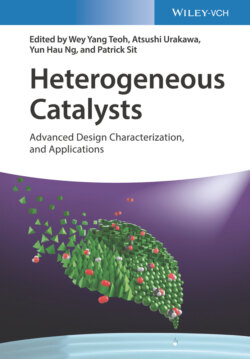Читать книгу Heterogeneous Catalysts - Группа авторов - Страница 63
4.4 Conclusions and Outlook
ОглавлениеThe optimization of catalyst prepared on activated carbon materials by conventional wet chemistry methods has usually relied on a trial and error approach due to its complex surface chemistry. Hence, the degree of control on particle size distribution remains very modest. The recent advancements in new carbon materials (CNTs, graphene, nanodiamonds, carbon nitride) along with the advances in the nanotechnology synthesis and characterization techniques have enabled the “catalyst by design” approach as complemented by theoretical and computational techniques.
High level of control of catalyst size and distribution has been achieved on carbon materials, from single‐atom catalysts and clusters of few atoms to nanometric particles. This has been possible in part because the nanostructure and surface chemistry of new carbon materials are well defined and tunable. The structure can be chosen between 0D (nanodiamonds), 1D (CNT), 2D (graphene, carbon nitride), and 3D carbon materials (aerogels). There is a variety of carbons from pure sp2 (graphene) to pure sp3 (nanodiamond) hybridization, carbons doped with different types and amounts of heteroatoms (doped graphene, carbon nitride).
Although some of the new carbon materials have extremely high surface area, they lack microporosity, rendering the entire surface accessible for the metal precursor and catalytic reactions. The porosity can be also tuned for synthetic laminated carbon materials (carbon nitride, CTF, graphene derivatives). It is recognized that the support material is not innocent in catalytic reaction, modulating the activity of metal catalyst, absorbing reactants or intermediates of reaction. Thus, metals can be supported on carbon supports affording different degrees of metal–support interactions. The electronic charge transfer between the metal and carbon material can also be tuned because the carbon supports can vary from highly conductive (graphene) to semiconductors (carbon nitride). All these tunable parameters can affect the subsequent catalytic activity and stability. Therefore, tailored catalysts can be prepared to meet the requirements of each specific reaction.
The range of carbon materials to choose as catalyst support is also open to carbon materials synthesized at the laboratory, starting from molecular building blocks. This group includes graphene derivatives (graphyne and graphdiyne), hydrothermal carbonization of carbohydrate precursors, or pyrolysis of MOFs. The preparation of catalyst on these carbon materials is still in its infancy and brings a wide field to be explored. Heteroatoms, especially nitrogen, doped on carbon materials can act as a surrogate of ligands in homogeneous catalysts stabilizing (SACs and tuning their activity. Therefore, SACs stabilized on carbon materials benefit from the high turnover and selectivity of homogeneous and enzymatic catalysts. On the other side, they also benefit from high stability and robustness of heterogeneous catalysis. Traditional wet chemistry synthesis techniques are applicable with an enhanced level of control on the new carbon materials. Emerging synthesis techniques (e.g. colloidal nanotechnology, ALD) have been successfully applied for the preparation of a myriad of new carbon‐based catalysts. Therefore, the array of carbon materials and the advances in preparation techniques have enriched the “carbon toolbox” for the preparation of tailored catalysts.
